BGO@ZnO Heterostructures for Ultrafast Scintillation Detectors
Abstract
1. Introduction
2. Materials and Methods
2.1. Preparation of ZnO Sol–Gel Films on BGO Substrates
2.2. Characterization
3. Results and Discussion
3.1. Characterization of ZnO Nanoparticles
3.2. Morphology of BGO@ZnO Heterostructures
3.3. Crystalline Structure of Obtained Heterostructures
3.4. Optical and Luminescent Properties
3.5. CTR Measurements
4. Conclusions
Author Contributions
Funding
Data Availability Statement
Acknowledgments
Conflicts of Interest
References
- Lecoq, P.; Morel, C.; Prior, J.O.; Visvikis, D.; Gundacker, S.; Auffray, E.; Križan, P.; Turtos, R.M.; Thers, D.; Charbon, E.; et al. Roadmap toward the 10 ps time-of-flight PET challenge. Phys. Med. Biol. 2020, 65, 21RM01. [Google Scholar] [CrossRef]
- ATLAS Collaboration. Observation of a new particle in the search for the Standard Model Higgs boson with the ATLAS detector at the LHC. Phys. Lett. B 2012, 716, 1–29. [Google Scholar] [CrossRef]
- Lucchini, M.T.; Chung, W.; Eno, S.C.; Lai, Y.; Lucchini, L.; Nguyen, M.; Tully, C.G. New perspectives on segmented crystal calorimeters for future colliders. J. Instrum. 2020, 15, P11005. [Google Scholar] [CrossRef]
- Vinogradov, S. Approximations of coincidence time resolution models of scintillator detectors with leading edge discriminator. Nucl. Instr. Meth. A 2018, 912, 149–153. [Google Scholar] [CrossRef]
- Schaart, D.R. Physics and technology of time-of-flight PET detectors, Physics in Medicine & Biology. Phys. Med. Biol. 2021, 66, 09TR01. [Google Scholar] [CrossRef]
- Derenzo, S.; Boswell, M.; Weber, K. Brennan at the Lawrence Berkeley National Laboratory with Support from the Department of Homeland Security (DHS). Available online: https://scintillator.lbl.gov/ (accessed on 14 September 2025).
- Turtos, R.M.; Gundacker, S.; Auffray, E.; Lecoq, P. Towards a metamaterial approach for fast timing in PET: Experimental proof-of-concept. Phys. Med. Biol. 2019, 64, 185018. [Google Scholar] [CrossRef]
- Turtos, R.M.; Gundacker, S.; Omelkov, S.; Mahler, B.; Khan, A.H.; Saaring, J.; Meng, Z.; Vasil’ev, A.; Dujardin, C.; Kirm, M.; et al. On the use of CdSe scintillating nanoplatelets as time taggers for high-energy gamma detection. Npj 2D Mater. Appl. 2019, 3, 37. [Google Scholar] [CrossRef]
- Pagano, F.; Kratochwil, N.; Salomoni, M.; Pizzichemi, M.; Paganoni, M.; Auffray, E. Advances in heterostructured scintillators: Toward a new generation of detectors for TOF-PET. Phys. Med. Biol. 2022, 67, 135010. [Google Scholar] [CrossRef]
- Shevelev, V.S.; Ishchenko, A.V.; Vanetsev, A.S.; Nagirnyi, V.; Omelkov, S.I. Ultrafast hybrid nanocomposite scintillators: A review. J. Lum. 2022, 242, 118534. [Google Scholar] [CrossRef]
- Chen, Q.; Wu, J.; Ou, X.; Huang, B.; Almutlaq, J.; Zhumekenov, A.A.; Guan, X.; Han, S.; Liang, L.; Yi, Z.; et al. All-inorganic perovskite nanocrystal scintillators. Nature 2018, 561, 88–93. [Google Scholar] [CrossRef]
- Xie, A.; Maddalena, F.; Witkowski, M.E.; Makowski, M.; Mahler, B.; Drozdowski, W.; Springham, V.; Coquet, P.; Dujardin, C.; Birowosuto, M.D.; et al. Library of two-dimensional hybrid lead halide perovskite scintillator, Crystals. Chem. Mater. 2020, 32, 8530–8539. [Google Scholar] [CrossRef]
- Procházková, L.; Gbur, T.; Cuba, V.; Jary, V.; Nikl, M. Fabrication of highly efficient ZnO nanoscintillators. Opt. Mater. 2015, 47, 67–71. [Google Scholar] [CrossRef]
- Koike, K.; Aoki, T.; Fujimoto, R.; Sasa, S.; Yano, M.; Gonda, S.; Ishigami, R.; Kume, K. Radiation hardness of single-crystalline zinc oxide films. Phys. Status Solidi C 2012, 9, 1577–1579. [Google Scholar] [CrossRef]
- Shao, Z.; Cai, Z.; Zhu, H.; Guo, H.; Chen, H.; Yang, F.; Song, X.; Li, J.; Zhang, Q. Influence of neutron/gamma irradiation on damage and scintillation of Ga-doped ZnO thin films. Radiat. Meas. 2023, 160, 106894. [Google Scholar] [CrossRef]
- Dujardin, C.; Auffray, E.; Bourret-Courchesne, E.; Dorenbos, P.; Lecoq, P.; Nikl, M.; Vasil, A.N.; Yoshikawa, A.; Zhu, R.Y. Needs, trends, and advances in inorganic scintillators. IEEE Trans. Nucl. Sci. 2018, 65, 1977–1997. [Google Scholar] [CrossRef]
- Moszynski, M.; Kapusta, M.; Mayhugh, M.; Wolski, D.; Flyckt, S.O. Absolute light output of scintillators. IEEE Trans. Nucl. Sci. 1997, 44, 1052–1061. [Google Scholar] [CrossRef]
- Rogers, E.G.; Birowosuto, M.D.; Maddalena, F.; Dujardin, C.; Pagano, F.; Kratochwil, N.; Auffray, E.; Krause, P.; Bizarri, G. Two-dimensional perovskite functionalized fiber-type heterostructured scintillators. Appl. Phys. Lett. 2023, 122, 081901. [Google Scholar] [CrossRef]
- Taieb, K.; Belkhir, N.; Khennab, A.; Rogers, E.; Giusca, C.; Bizarri, G. High-precision machining behavior of the single crystal scintillator, bismuth germanate (Bi4Ge5O12). Mater. Today Commun. 2025, 46, 112620. [Google Scholar] [CrossRef]
- Anand, V.; Krause, P.; Bansal, B.; Bizarri, G.; Kumar, G.A.; Ranga, V.; Sharma, V. 3D-Printed Plastic Scintillator: A Potential Avenue for Hetero-Structured Radiation Detectors. IEEE Trans. Nucl. Sci. 2025, 72, 2100–2105. [Google Scholar] [CrossRef]
- Orfano, M.; Pagano, F.; Mattei, I.; Cova, F.; Secchi, V.; Bracco, S.; Rogers, E.; Barbieri, L.; Lorenzi, R.; Bizarri, G.; et al. Fast emitting nanocomposites for high-resolution ToF-PET imaging based on multicomponent scintillators. Adv. Mater. Technol. 2024, 9, 2302075. [Google Scholar] [CrossRef]
- Krause, P.; Rogers, E.; Bizarri, G. Advances in design of high-performance heterostructured scintillators for time-of-flight positron emission tomography. Adv. Theory Simul. 2024, 7, 2300425. [Google Scholar] [CrossRef]
- Sans, J.A.; Segura, A.; Mollar, M.; Mari, B. Optical properties of thin films of ZnO prepared by pulsed laser deposition. Thin Solid Films 2004, 251, 453–454. [Google Scholar] [CrossRef]
- Lee, G.H. Optical properties of ZnO thin films on LiNbO3 and LiTaO3 substrates grown by pulsed laser deposition. Solid State Commun. 2003, 128, 351. [Google Scholar] [CrossRef]
- Lee, J.B.; Kwak, S.H.; Kim, H.J. Effects of surface roughness of substrates on the c-axis preferred orientation of ZnO films deposited by r.f. magnetron sputtering. Thin Solid Films 2003, 423, 262–266. [Google Scholar] [CrossRef]
- Cuadra, J.G.; Estrada, A.C.; Oliveira, C.; Abderrahim, L.A.; Porcar, S.; Fraga, D.; Trindade, T.; Seabra, M.P.; Labrincha, J.; Carda, J.B. Functional properties of transparent ZnO thin films synthetized by using spray pyrolysis for environmental and biomedical applications. Ceram. Int. 2023, 49, 32779–32788. [Google Scholar] [CrossRef]
- Paul, G.K.; Bandyopadhyay, S.; Sen, S.K.; Sen, S. Structural, optical and electrical studies on sol–gel deposited Zr doped ZnO films. Mater. Chem. Phys. 2003, 79, 71–75. [Google Scholar] [CrossRef]
- Zhang, W.; Li, P.; Li, Y.; Chen, H.; Wang, X.; Ma, J.; Zhao, X. Structural, optical and electrical properties of sol-gel spin-coated Ga and F Co-doped ZnO films. Thin Solid Films 2022, 746, 139121. [Google Scholar] [CrossRef]
- Beek, W.J.E.; Wienk, M.M.; Kemerink, M.; Yang, X.; Janssen, R.A.J. Hybrid zinc oxide conjugated polymer bulk heterojunction solar cells. J. Phys. Chem. B 2005, 109, 9505–9516. [Google Scholar] [CrossRef]
- Alwan, R.M.; Kadhim, Q.A.; Sahan, K.M.; Ali, R.A.; Mahdi, R.J.; Kassim, N.A.; Jassim, A.N. Synthesis of zinc oxide nanoparticles via sol–gel route and their characterization. J. Nanosci. Nanotechnol. 2015, 5, 1–6. [Google Scholar] [CrossRef]
- Ananthakrishnan, R.; Goswami, K. Deciphering the effect of calcination temperature on crystallinity, morphology, oxygen vacancy and photocatalytic activity of bi-phasic ZnO/ZnCo2O4 heterostructured nanomaterials. Mater. Chem. Phys. 2024, 327, 129792. [Google Scholar] [CrossRef]
- Klingshirn, C.; Priller, H.; Decker, M.; Bruckner, J.; Kalt, H.; Hauschild, R.; Zeller, J.; Waag, A.; Bakin, A.; Wehmann, H.; et al. Excitonic properties of ZnO. Adv. Solid State Phys. 2005, 45, 275–287. [Google Scholar] [CrossRef]
- Kenanakisa, G.; Androulidaki, M.; Koudoumas, E.; Savvakis, C.; Katsarakis, N. Photoluminescence of ZnO nanostructures grown by the aqueous chemical growth technique. Superlattices Microstruct. 2007, 42, 473–478. [Google Scholar] [CrossRef]
- Gruzintsev, A.N.; Dulina, N.A.; Emel, G.A.; Ermolaeva, Y.V.; Kudrenko, E.A.; Tolmachev, A.V. Optical properties of spherical monodisperse Y2O3-ZnO nanoparticles. Phys. Solid State 2012, 54, 2260–2265. [Google Scholar] [CrossRef]
- Mohr, P.; Efthimiou, N.; Pagano, F.; Kratochwil, N.; Pizzichemi, M.; Tsoumpas, C.; Auffray, E.; Ziemonset, K. Image Reconstruction Analysis for Positron Emission Tomography with Heterostructured Scintillators. IEEE Trans. Radiat. Plasma Med. Sci. 2023, 7, 41–51. [Google Scholar] [CrossRef] [PubMed]
- Pagano, F.; Kratochwil, N.; Martinazzoli, L.; Lowis, C.; Paganoni, M.; Pizzichemi, M.; Auffray-Hillemans, E. Modeling scintillation kinetics and coincidence time resolution in heterostructured scintillators. IEEE Trans. Nucl. Sci. 2023, 70, 2630–2637. [Google Scholar] [CrossRef]
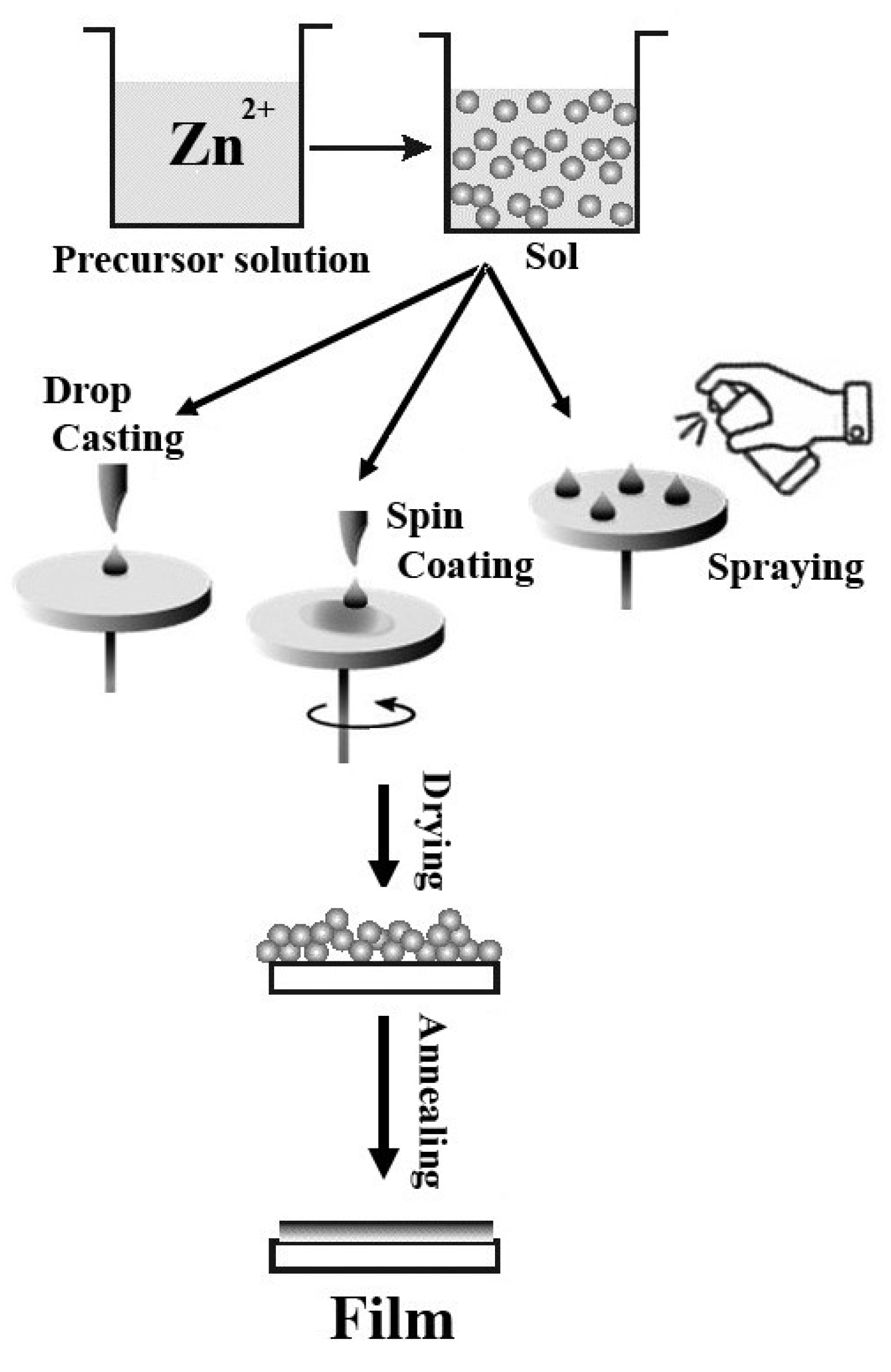

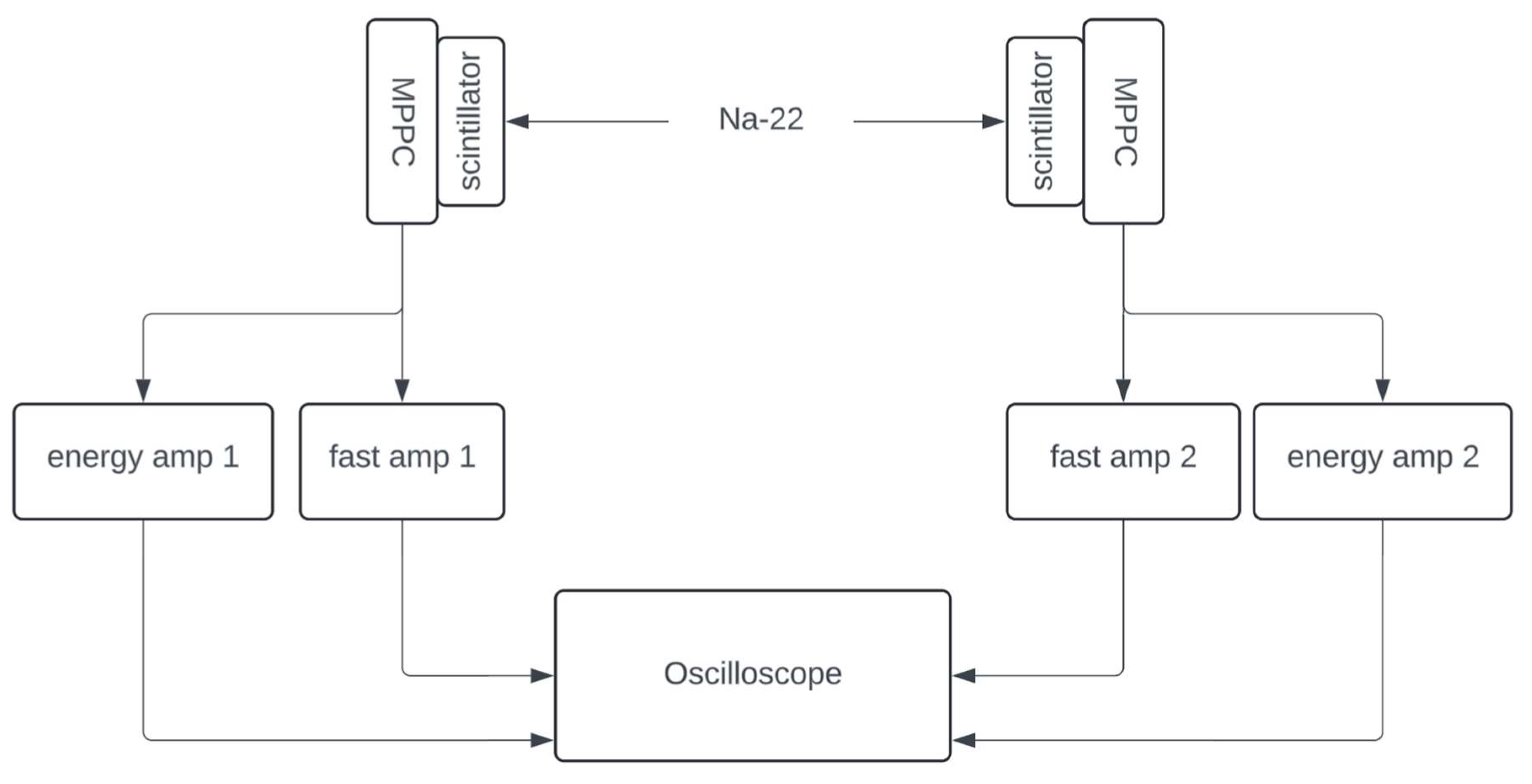
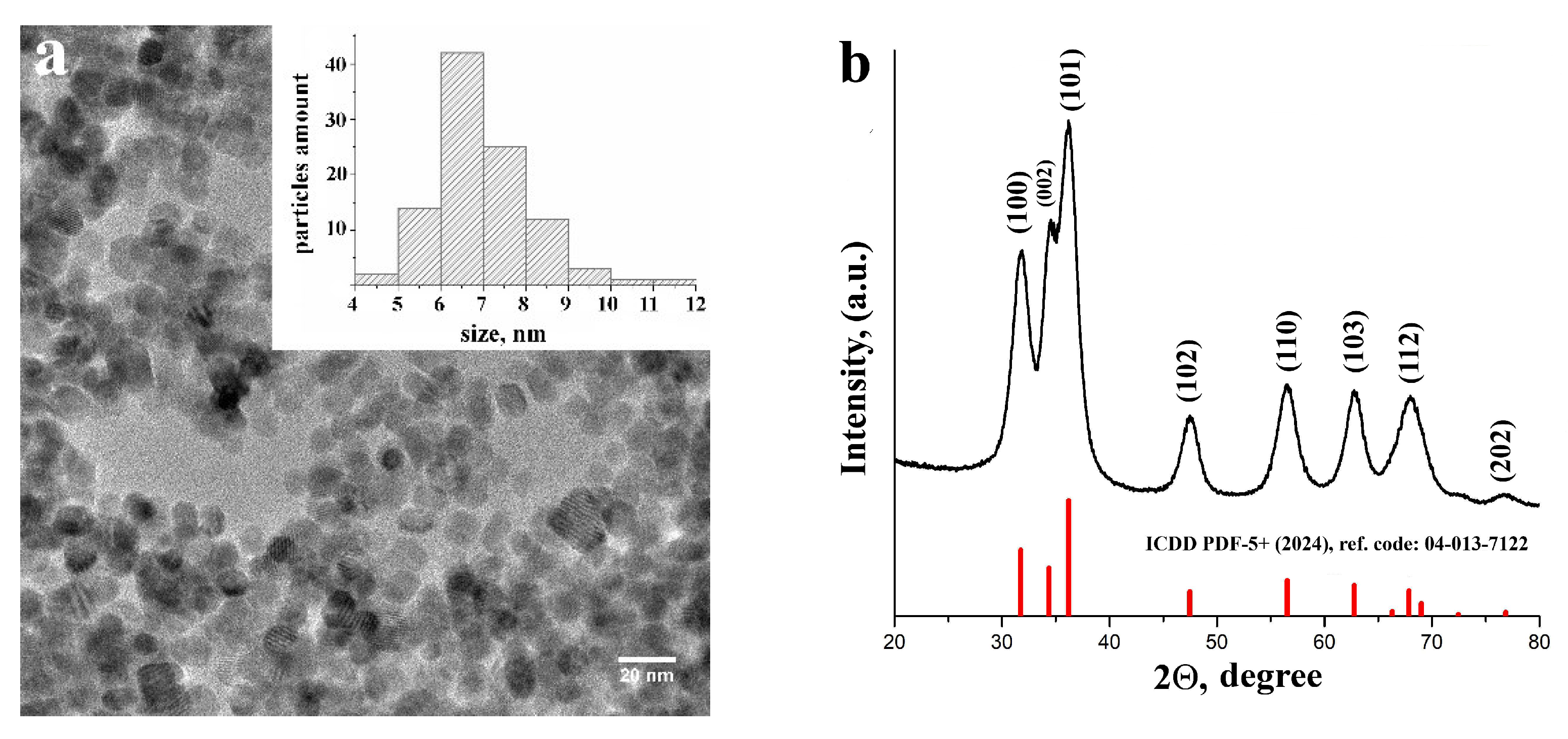
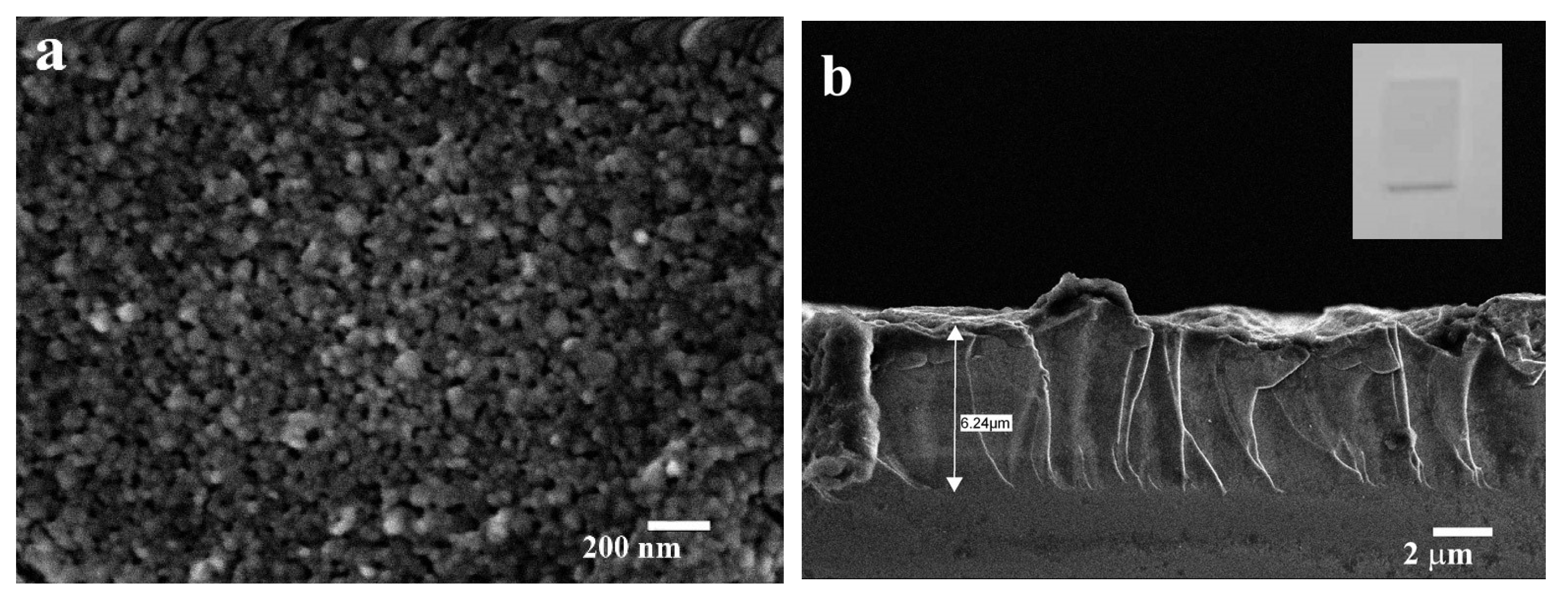
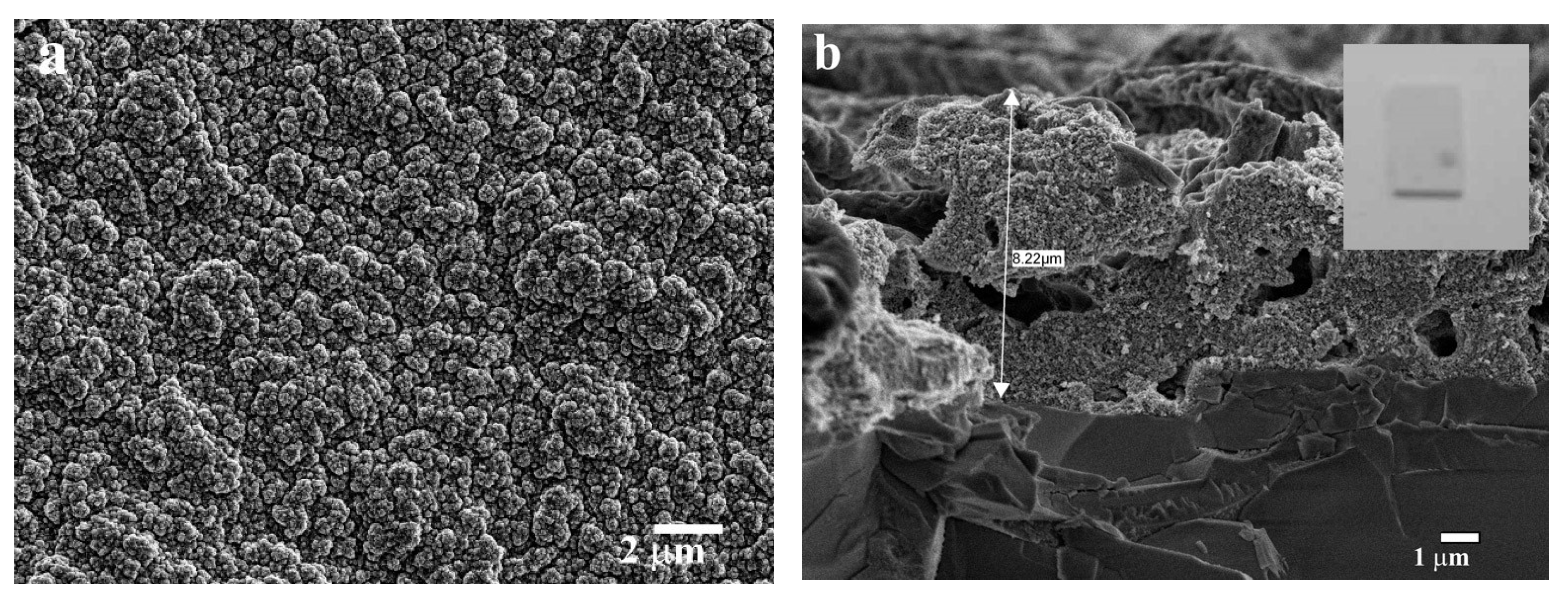





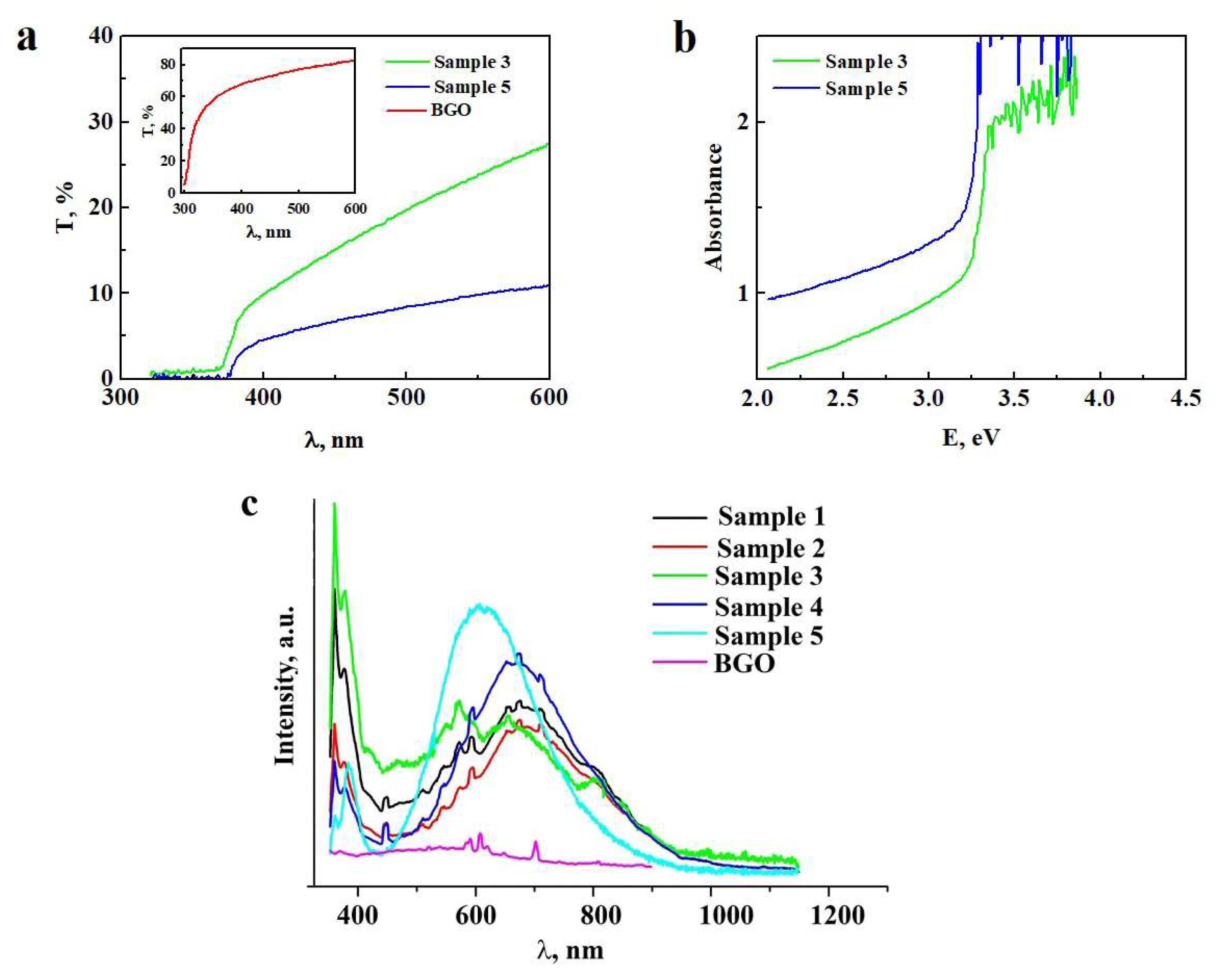
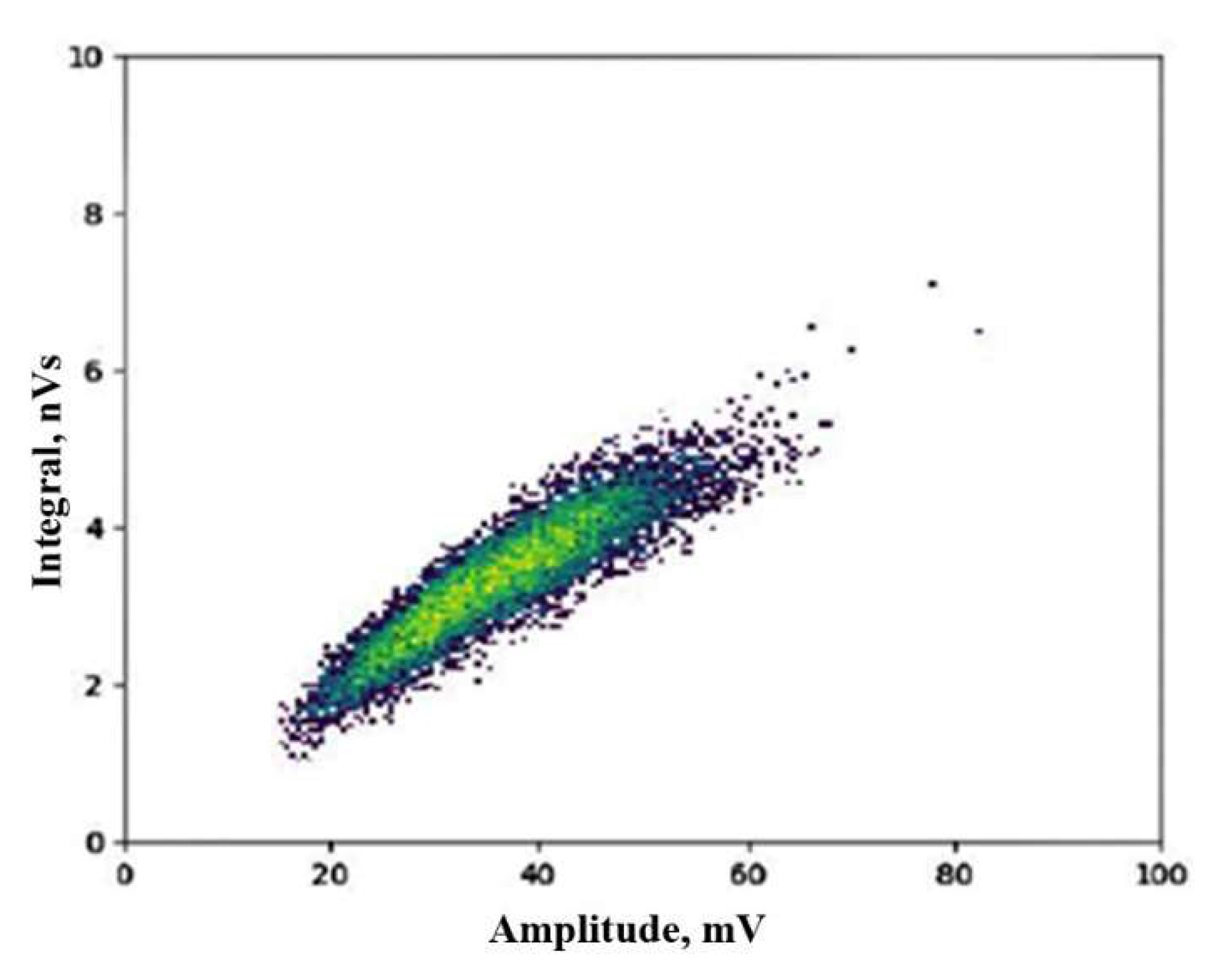
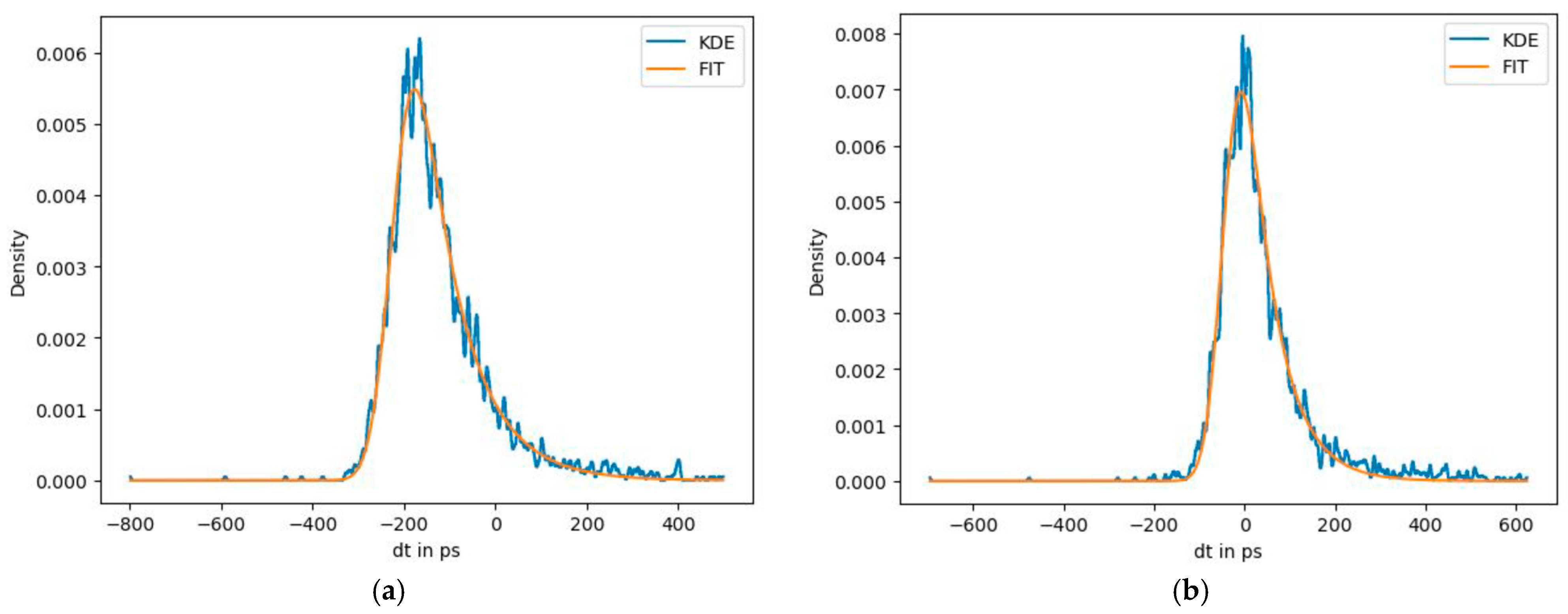
| Sample Name | Sample Preparation |
|---|---|
| Sample 1 | Precursor 1, spin coating |
| Sample 2 | Precursor 1, drop casting |
| Sample 3 | Precursor 2, spin coating |
| Sample 4 | Precursor 2, drop casting |
| Sample 5 | Precursor 2, spray coating |
| Sample 1 | Sample 2 | Sample 3 | Sample 4 | Sample 5 | |
|---|---|---|---|---|---|
| Space Group—P63mc (186) and Structure—Hexagonal | |||||
| a (Å) | 3.2490 | 3.2496 | 3.2505 | 3.2511 | 3.2522 |
| c (Å) | 5.2057 | 5.2067 | 5.2070 | 5.2068 | 5.2075 |
| V (Å) | 47.62 | 47.67 | 47.73 | 47.75 | 47.81 |
| O (1/3 2/3 z) | |||||
| 2b | |||||
| z | 0.378 | 0.381 | 0.385 | 0.386 | 0.389 |
| Χ2 | 5.78 | 4.33 | 3.52 | 4.73 | 6.12 |
| Rwp | 10.2 | 8.78 | 7.32 | 8.34 | 9.87 |
| Crystallite size (Å) | 107.6 | 515.3 | 517.3 | 348.0 | 49.0 |
| Scintillator | LSO:Ce: Ca 3 × 2 × 2 mm3 | BGO [35] | BGO@ZnO (Spin-Coating, Sample 3) | BGO@ZnO (Spray Coating, Sample 5) | BGO@ZnO (Spray Coating, Sample 5) + Silicone Coupling |
|---|---|---|---|---|---|
| CTR [ps] | 61 | 276 | 203 ± 9 | 190 ± 10 | 158 ± 8 |
Disclaimer/Publisher’s Note: The statements, opinions and data contained in all publications are solely those of the individual author(s) and contributor(s) and not of MDPI and/or the editor(s). MDPI and/or the editor(s) disclaim responsibility for any injury to people or property resulting from any ideas, methods, instructions or products referred to in the content. |
© 2025 by the authors. Licensee MDPI, Basel, Switzerland. This article is an open access article distributed under the terms and conditions of the Creative Commons Attribution (CC BY) license (https://creativecommons.org/licenses/by/4.0/).
Share and Cite
Babayevska, N.; Jancelewicz, M.; Iatsunskyi, I.; Jarek, M.; Yakymenko, I.; Padmanaban, A.; Viahin, O.; Terragni, G.; Lowis, C.; Auffray, E.; et al. BGO@ZnO Heterostructures for Ultrafast Scintillation Detectors. Crystals 2025, 15, 820. https://doi.org/10.3390/cryst15090820
Babayevska N, Jancelewicz M, Iatsunskyi I, Jarek M, Yakymenko I, Padmanaban A, Viahin O, Terragni G, Lowis C, Auffray E, et al. BGO@ZnO Heterostructures for Ultrafast Scintillation Detectors. Crystals. 2025; 15(9):820. https://doi.org/10.3390/cryst15090820
Chicago/Turabian StyleBabayevska, Nataliya, Mariusz Jancelewicz, Igor Iatsunskyi, Marcin Jarek, Ivan Yakymenko, Aravinthkumar Padmanaban, Oleh Viahin, Giulia Terragni, Carsten Lowis, Etiennette Auffray, and et al. 2025. "BGO@ZnO Heterostructures for Ultrafast Scintillation Detectors" Crystals 15, no. 9: 820. https://doi.org/10.3390/cryst15090820
APA StyleBabayevska, N., Jancelewicz, M., Iatsunskyi, I., Jarek, M., Yakymenko, I., Padmanaban, A., Viahin, O., Terragni, G., Lowis, C., Auffray, E., & Sidletskiy, O. (2025). BGO@ZnO Heterostructures for Ultrafast Scintillation Detectors. Crystals, 15(9), 820. https://doi.org/10.3390/cryst15090820






